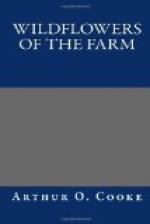Gorse, Heather, and Heath are spreading plants, and, if they were allowed to grow unchecked, they would soon smother and destroy the turf. Every few years therefore the Chase is burnt. In winter or spring both Gorse and Heath burn easily, the fire spreading fast from one patch to another. The smoke of the burning Chase may then be seen from many miles away.
When the fire has burnt out, the Chase looks very black and dismal. But the roots and underground stems of both the Heather and the Gorse are still alive. Fresh shoots will grow, and soon the Gorse will be golden in the spring, the Heather purple in the summer, as they were before.
CHAPTER XII
IN THE LANES
This is the last day that we can spend in looking for wild flowers at Willow Farm. Perhaps some of you already knew something about flowers before this visit. If so, you may have been disappointed that we have not seen some favourite flower of your own. You may think we have passed over many flowers which deserved to be noticed.
For that matter I think every wild flower deserves to be noticed; but we certainly should not have time for all. I showed you several plants growing on the walls and roof, because it was interesting to see that quite beautiful flowers, such as the Wallflower and the Houseleek, could grow with very little soil. We looked rather closely at the Clovers and at the Grasses in the hay-field, because these plants are important to the farmer; they are part of his crops. Then, too, we noticed several weeds which do him harm.
To-day I am going to take a kind of holiday. I shall show you three flowers, not because they have much to do with the farmer, but because they are great favourites of my own.
None of these are very common at Willow Farm, although I know where to find each one. We will go first down the little stony lane which leads from near the foldyard gate to the cottages where the shepherd and the bailiff live. Here we shall find the Alkanet. It is a perennial, and it blossoms here year after year. I only know one other place in the village where it grows. Like some other flowers we have seen, it is not really a native of England.
It has a very beautiful blue blossom, a little like the blossom of the Forget-me-not which perhaps you know, but the flower of the Alkanet is of a deeper, richer blue. Here again, as with so many other flowers we have seen, the blossom is formed of the five lobes of a corolla. In the centre of each blue blossom is a small white spot.
The blossoms grow in little clusters on a short stalk, and on this stalk there is always one pair of small leaves. The leaves on the main stems of the plant are larger; the lower leaves have stalks, but those on the upper part of the stem are sessile. The leaves are hairy, and so are the stems, which often grow two or three feet high.




